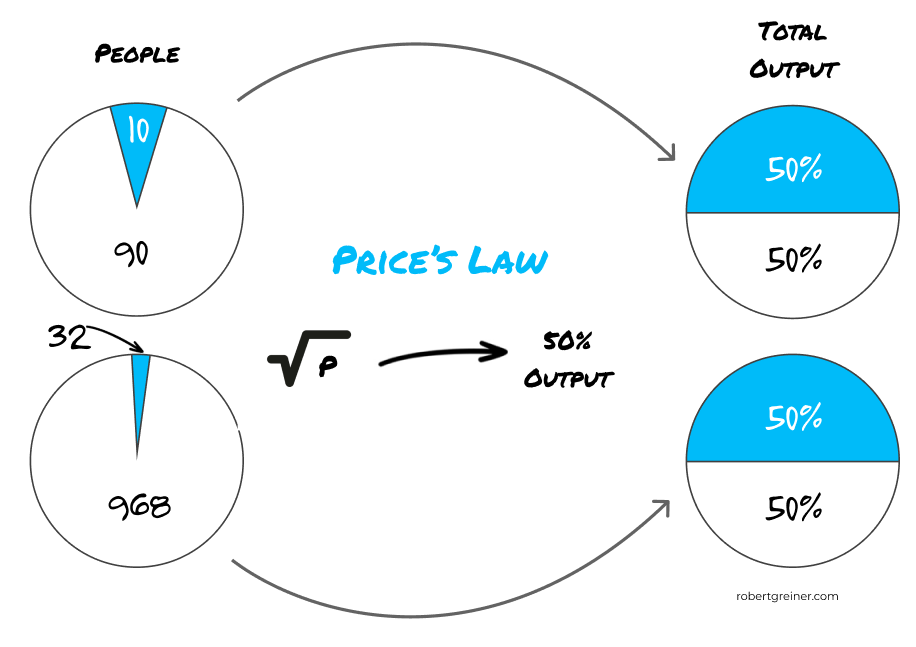More Salespeople, More Revenue? Think Again.
How ignoring Price's Law could bankrupt your sales strategy.

We've all been there. Revenue takes a dip or growth targets loom large, and the drumbeat starts: "We need more revenue! Hire more sellers." It's a reflex, almost involuntary, like that jolt your leg makes when the doctor taps your knee with a rubber mallet. What a simple and straightforward solution. It feels good too, who doesn't want to grow their team?
If only...
The Illusion and Allure of the Pareto Principle
The Pareto Principle has been the guiding star for growing organizations since before Vilfredo Pareto coined the term in 1896: 80% of the output comes from 20% of the team. Nice, neat, and tidy. You have a team of 10 sales reps? Congrats, two of them are your rainmakers pulling in around 80% of the revenue. Scale that to a hundred, and, by that logic, you'd expect 20 people to carry the day. Sounds pretty fantastic, doesn’t it?
While the 80/20 rule is a great rule-of thumb, it's also a misleading fantasy that could lead your organization straight into a financial crisis. The Pareto principle only tells part of the story.
Enter Price's Square Root Law
Let's get acquainted with a law of the universe that is much less forgiving: Price's Square Root Law. The law is often used to illustrate the concept of a "productive core" in science and other collaborative disciplines, where a small number of individuals are responsible for a large proportion of the overall output.
According to Price's law, 50% of an organization's results come from the square root of the total number of people in the group.
- A sales team of 10? Three people are doing half the heavy lifting.
- Blow that up to 50? Seven people.
- One hundred? That's just 10 people.
- And a team of 1,000? Only 31 are driving half your sales.
Feeling sober yet? Our bright idea to hire more salespeople just introduced a ton of complexity into our tidy organization. I've fallen into this trap too many times to count. And, worse, it's still my default instinct to this day. I can't help but think the answer to my revenue woes must be a result of a lack of sellers.

The Curse of Diminishing Returns
Unfortunately, as you add more salespeople, you end up fighting against the relentless tide of diminishing returns - one of the most powerful forces in the universe, alongside compound interest.
The system becomes increasingly inefficient as you add more "nodes" (headcount). Worse, complexity scales faster than revenue, not to mention the built-in lag time between hiring a person and them being productive. If we aren't careful and hire too quickly, or when we don't really need people but think we do, we end up creating a monster that eats its own tail.
Sales Enablement: Your Secret Weapon
Sometimes you need more sales reps. No argument there.
But far more often, energy and resources are more effectively utilized on sales enablement. Increasing revenue-per-salesperson can often be a far more effective lever to pull than just throwing more bodies at the problem.
Before spinning up the recruiting machine, are the following elements of the oganization in-tact?
- Onboarding Programs: Effective sales enablement starts with a strong onboarding program for new hires. This sets the foundation by introducing company culture, product knowledge, and basic sales skills, ensuring that new sales reps are well-prepared to start generating revenue as quickly as possible.
- Organizational Simplification and Focus: Cutting through organizational red tape and focusing on what truly matters for sales success is crucial. Sales enablement can play a role in identifying and eliminating internal complexities and distractions, enabling the sales force to focus solely on activities that directly contribute to revenue generation.
- Training and Education: Sales representatives need ongoing training on the products or services they are selling, the evolving industry landscape, and effective selling techniques. This often includes product knowledge, objection handling, and soft skills training.
- Content and Resources: Sales teams require up-to-date marketing materials, case studies, presentations, and other content that can help them effectively communicate the value proposition to potential customers and challenge when necessary.
- Technology and Tools: Sales enablement technology like Customer Relationship Management (CRM) software, sales analytics tools, and communication platforms can streamline processes and provide valuable insights.
- Sales Processes and Methodologies: Clearly defined sales processes, from lead generation to closing, help standardize activities and make performance easier to measure. Adhering to proven sales methodologies can help reps navigate complex sales cycles.
- Performance Metrics and Analytics: Ongoing measurement and analysis are crucial for understanding how well the sales enablement efforts are working. Key performance indicators (KPIs) should be established to gauge both individual and team effectiveness in reaching sales goals. If a metric is out of balance, the items above can help you get it back on track.
This is just the tip of the iceberg, and we will dig into each over time. Hopefully this list serves as a starting checklist of areas to explore before making that next hire.
The Sales Leader's Reality
Creating a bigger team isn't always the answer. Sure, the numbers might go up, but so does the chaos. Handoffs get messier, sales cycles grow longer, the organization requires more layers, humans get distracted, and the act of coordinating everyone starts to resemble a circus act more than a finely tuned machine.
So what’s the answer?
Essential focus. Not just on growth, but on sustainable growth. Think about maximizing each salesperson's output before adding more reps. Leverage the data around you to make smarter decisions. Are we firing on all cylinders, or are there clear improvements to make before adding more complex humans into the ecosystem?
It's not just about getting bigger; it’s about getting smarter, more efficient, and through all of that, more profitable.

In Dieter Rams' book Less but Better, he advocates for beautiful design through Simplicity over Complexity (stripping away non-essential features), Long-Lasting Design (sustainable, repeatable, and predictable), and Functional Relevance (efficient interaction). Equally as applicable whether you are building the next version of the iPhone, or a well-oiled sustainable sales organization.
The best sales leaders find the Goldilocks zone between hiring and enablement. Some quarters may be more heavily weighted on one end of the spectrum than the other, but the overall trend line should show a level of balance and intentionality.
Your Job Isn't Just to Add, It’s to Multiply
Look, more salespeople will almost always bring in more revenue, but is the cost worth the benefit? Adding too many people, too quickly will generate unnecessary and crippling complexity, inefficiency, and distraction, leading to a hemorrhaging bottom line.
If you find yourself impulsively reaching for that "Hire More" button every time you’re under the gun to boost revenue, pause. Consider Price, take a hard look at your metrics, and ask whether or not your resources would be better spent on enablement. Remember: your job isn’t just to add - it's to multiply.
So next time you feel the pressure to simply add more salespeople for the sake of revenue, consider this: what you really need may not be more numbers, but more value. And that, my friends, is how you build a sales organization that not just survives, but thrives.
How did you like this article? Your feedback helps me create better content.
Thanks for reading.
Subscribe for Free
Want to stay ahead of the curve? Subscribe now to receive the latest updates, actionable insights, and thought-provoking ideas around business, technology, and leadership straight to your inbox.



